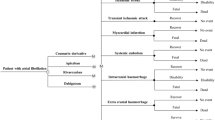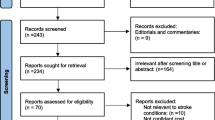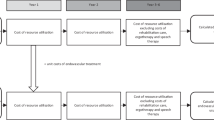Abstract
Objectives: To evaluate the cost effectiveness from a UK health and social services perspective of antiplatelet therapies tested in the Second European Stroke Prevention Study (ESPS-2) in preventing recurrent stroke. To demonstrate the value of modelling studies in this area.
Design and setting: A decision-analytic model was developed to evaluate health outcomes and associated costs. Sources of data for efficacy, adverse events, background event risks, disability and mortality were ESPS-2, the Oxfordshire Community Stroke Project and UK national statistics. Published national unit costs were applied to clinician panel estimates of resource use for acute stroke, rehabilitation and long term care. Outcome measures were strokes or disabled life-years averted, and disability-free, stroke-free or quality-adjusted life-years gained.
Patients and interventions: 30-day survivors of ischaemic stroke treated with low dose aspirin, modified-release dipyridamole; the coformulation of low dose aspirin plus modified-release dipyridamole, or no antiplatelet therapy.
Main outcome measures and results: The model predicted that over 5 years the coformulation prevented 29 more strokes than aspirin alone per 1000 patients, at an additional cost of £1900 per stroke averted (1996 values). Over 5 years, each antiplatelet therapy was cost saving compared with no therapy. Results were sensitive to the cost of acute care, the cost of long term care of disabled stroke survivors, the effectiveness of therapy and the background risk of recurrent stroke. In sensitivity analyses, the cost effectiveness did not exceed £7000 per stroke averted or £11 000 per quality-adjusted life-year (QALY) gained, except when varying the effectiveness parameter.
Conclusions: Application of a decision-analytic model to the results of ESPS-2 indicated that first-line therapy with the coformulation of modified-release dipyridamole and low dose aspirin to patients with a previous ischaemic stroke is likely to generate significant health benefits at modest extra costs to health and social services. The extra costs of treatment are balanced by the savings in future costs of acute care and long term care of the disabled. Future economic evaluations in this area should pay particular attention to the cost perspective, the duration of analysis, the selection of trials from which effectiveness data are derived, and the impact of the pooling of outcome events with potentially different economic consequences.
Similar content being viewed by others
References
Wade DT. Stroke (acute cerebrovascular disease). In: Stevens A, Raftery J eds. Health care needs assessment: the epidemiologically based needs assessment reviews. Vol. 1. Oxford: Radcliffe Medical Press, 1994
Office of Health Economics (OHE). Office of Health Economics. Stroke 1988
Isard PA, Forbes JF. The cost of stroke to the National Health service in Scotland. Cerebrovasc Dis 1992; 2: 47–50
Bergman L, ven der Meulen JHP, Limburg M, et al. Cost of medical care after first-ever stroke in the Netherlands. Stroke 1995; 26: 1830–6
Terent A, Marke L-A, Asplund K, et al. Costs of stroke in Sweden. A national perspective. Stroke 1994; 25: 2363–9
Taylor TN, Davis PH, Torner JC, et al. Lifetime cost of stroke in the United States. Stroke 1996; 27: 1459–66
Porsdal V, Boysen G. Cost-of illness studies of stroke. Cerebrovasc Dis 1997; 7: 258–63
Antiplatelet Trialists’Collaboration. Collaborative overview of randomised trials of antiplatelet therapy - I: prevention of death, myocardial infarction, and stroke by prolonged antiplatelet therapy in various categories of patients. BMJ 1994; 308: 81–106
Hass WK, Easton JD, Adams HP, et al. Arandomized trial comparing ticlopidine hydrochloride with aspirin for the prevention of stroke in high-risk patients. N Engl J Med 1989; 321: 501–7
Gent M, Easton JD, Hachinski VC, et al. The Canadian American Ticlopidine Study (CATS) in thromboembolic stroke. Lancet 1989 Jun 3; 1 (8649): 1215–20
The ESPS Group. The European Stroke Prevention Study (ESPS): Principal End-points. Lancet 1987 Dec 12; 2 (8572): 1351–4
Diener HC, Cunha L, Forbes C, et al. European Stroke Prevention Study 2. Dipyridamole and acetylsalicylic acid in the secondary prevention of stroke. J Neurol Sci 1996; 143: 1–13
The ESPS-2 Group. European Stroke Prevention Study 2. Efficacy and safety data. J Neurol Sci 1997; 151: S1-S77
CAPRIE steering Committee. A randomised, blinded, trial of clopidogrel versus aspirin in patients at risk of ischaemic events (CAPRIE) Lancet 1996; 348: 1329–39
Royal College of Physicians of Edinburgh. Consensus conference on the medical management of stroke consensus statement [online]. Available from: URL: http://www.rcpe.ac.uk/round/stroke.html [accessed 1998 May 27]
Oster G, Huse DM, Lacey MJ, et al. Cost-effectiveness of ticlopidine in preventing stroke in high-risk patients. Stroke 1994; 25: 1149–56
Scott G, Scott HM. Application of the findings of the European Stroke Prevention Study 2 (ESPS-2) to a New Zealand ischaemic stroke cost analysis. Pharmacoeconomics 1997; 12 (6): 667–74
Alexandrov AV, Smurawska LT, Bartle W, et al. Cost considerations in the pharmacological prevention and treatment of stroke. Pharmacoeconomics 1997; 11: 408–18
Weinstein MC, Fineberg HV. Clinical decision analysis. WB Saunders, Philadelphia 1980
DH/ABPI Guidelines for the economic evaluation of pharmaceuticals. Department of Health, May 1994
Burn J. The outcome of a first stroke: the Oxford Community Stroke Project. MD thesis: University of Oxford 1991
Burn J, Dennis M, Bamford J, et al. Long-term risk of recurrent stroke after a first-ever stroke: the Oxfordshire Community Stroke Project. Stroke 1994; 25: 333–7
Rankin J. Cerebral vascular accidents in people over the age of 60. II Prognosis. Scott Med J 1957; 2: 200–15
II Prognosis. Scott Med J 1957; 2: 200–15
van Swieten JC, Koudstaal PJ, Visser MC, et al. Interobserver agreement for the assessment of handicap in stroke patients. Stroke 1988; 19: 604–7
Office of Population Census and Surveys (OPCS). Mortality statistics 1991: Cause. HMSO 1993; Series DH2(18)
Chartered Institute of Public Finance and Accountancy (CIPFA). Health Database 1995. Volume 3A Provider Database: Activity Costs Analysis CIPFA 1995
Netten A, Dennett J, editors. Unit costs of health and social care 1996. Personal Social Services Research Unit. University of Kent, 1996
CHKS. Acute Care 95: Healthcare Resource Groups. National Statistics 1994/95. CHKS Ltd, Alcester, Warwickshire, UK 1995
MIMS Monthly Index of Medical Specialities. December 1996
Gage BF, Cardinalli AB, Albers GW, et al. Cost-effectiveness of warfarin and aspirin for prophylaxis of stroke in patients with nonvalvular atrial fibrillation. JAMA 1995; 274 (23): 1839–45
Overell J, Walker A, Weir C, et al. The cost effectiveness of clopidogrel and the combination of aspirin and dipyridamole in stroke prevention. Cerebrovasc Dis 1999; 9 (1 Suppl.): 66
Buxton M, Drummond M, Van Hout B, et al. Modelling in economic evaluation: an unavoidable fact of life. Health Economics 1997; 6: 217–27
Glick H, Kinosian B, Schulman K. Decision analytic modeling: some uses in the evaluation of new pharmaceuticals. Drug Inf J 1994; 28: 691–707
Brown RD, Whisnant JP, Sicks RD, et al. Stroke incidence, prevalence and survival. Secular trends in Rochester, Minnesota, through 1989. Stroke 1996; 27: 373–80
Sacco RL, Wolf PA, Kennel WB, et al. Survival and recurrence following stroke: the Framingham study. Stroke 1982; 13: 290–5
Petty GW, Brown RD, Sicks J, et al. Survival and recurrence after first cerebral infarction in Rochester, Minnesota, 1975–89. Cerebrovasc Dis 1996; 6 Suppl. 2: 6–7
Sacco RL, Shi T, Zamanillo MC, et al. Predictors of mortality and recurrence after hospitalized cerebral infarction in an urban community: the Northern Manhattan Stroke Study. Neurology 1994; 44: 626–34
Easton JD. Epidemiology of stroke recurrence. Cerebrovasc Dis 1997; 7 Suppl. 1: 2–4
Dombovy ML, Basford JR, Whisnant JP, et al. Disability and use of rehabilitation services following stroke in Rochester, Minnesota, 1975–1979. Stroke 1987; 18: 830–6
Matchar DB, McCrory DC, Barnett HJM, et al. Medical treatment for stroke prevention. Ann Int Med 1994; 121: 41–53
Hart RG, Harrison MJG. Aspirin wars: the optimal dose of aspirin to prevent stroke. Stroke 1996; 27: 585–7
Barnett HJM, Kaste M, Meldrum H, et al. Aspirin dose in stroke prevention. Beautiful hypotheses slain by ugly facts. Stroke 1996; 27: 588–92
Department of Health and Human Services (DHHS), Food and Drug Administration, 21CFRPart 243 [docket No. 77N-094A]. Internal analgesic, antipyretic and antirheumatic drug products for over-the-counter human use: final rule for professional labeling of aspirin, buffered aspirin, and aspirin in combination with antacid products. Federal Register 1998; 63 (205); 56802–19
De Schryver ELLM on behalf of the ESPRIT study group. ESPRIT: mild anticoagulation, acetylsalicylic acid plus dipyridamole or acteylsalicylic acid alone after cerebral infarction of arterial origin. Cerebrovasc Dis 1998; 8 Suppl. 4: 83
Department of Health (DH). Hospital Episode Statistics: Volume 1. 1993–94. UK Department of Health 1995
Pollock S. A district stroke service. Br J Hosp Med 1997; 57: 224–8
Beech R, Ratcliffe M, Tilling K, et al. on behalf of the participants of the European Study of Stroke Care. Hospital Services for Stroke Care: a European perspective. Stroke 1996; 27: 1958–64
Gladman J, Whynes D, Lincoln N, for the DOMINO group. Cost comparison of domiciliary and hospital-based stroke rehabilitation. Age Ageing 1994; 23: 241–5
Young J, Forster A. Day hospital and home physiotherapy for stroke patients: a comparative cost-effectiveness study. J Royal Coll Phys 1993; 27: 252–8
Gladman J, Albazzaz M, Barer D. A survey of survivors of acute stroke discharged from hospital to private nursing homes in Nottingham. Health Trends 1991; 23: 158–60
Stroke Unit Trialists’ Collaboration. Collaborative systematic review of the randomised trials of organised inpatient (stroke unit) care after stroke. BMJ 1997; 314: 1151–9
Wilkinson PR, Wolfe C, Warburton FG, et al. A long-term follow-up of stroke patients. Stroke 1997; 28: 507–42
Author information
Authors and Affiliations
Corresponding author
Rights and permissions
About this article
Cite this article
Chambers, M., Hutton, J. & Gladman, J. Cost-Effectiveness Analysis of Antiplatelet Therapy in the Prevention of Recurrent Stroke in the UK. Pharmacoeconomics 16, 577–593 (1999). https://doi.org/10.2165/00019053-199916050-00013
Published:
Issue Date:
DOI: https://doi.org/10.2165/00019053-199916050-00013




